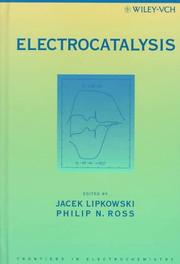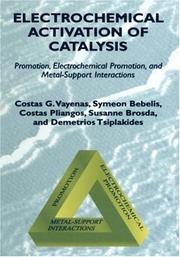| Listing 1 - 2 of 2 |
Sort by
|

ISBN: 0471246735 Year: 1998 Publisher: New York : Wiley-VCH,
Abstract | Keywords | Export | Availability | Bookmark
 Loading...
Loading...Choose an application
- Reference Manager
- EndNote
- RefWorks (Direct export to RefWorks)
A comprehensive review of advances in one of today's most technologically important research fields.Spurred on by society's increasingly urgent demand for an inexpensive, environment-friendly alternative to the internal combustion engine, research into electrocatalytic fuel cells has yielded many exciting advances in the past few years. This rapid rate of progress, however, has created a daunting challenge for anyone attempting to track the important new trends in electrocatalysis by sorting through the huge and rapidly growing body of world literature in the field.Electrocatalysis was designed to save scientists hours of arduous legwork by providing an authoritative review of the most important recent advances in all technologically relevant aspects of electrocatalysis. Leading researchers from North America, Europe, and the Far East share what they know about an array of related topics, including:* Electrocatalysis of hydrogen and oxygen electrode reactions* Electrooxidation of small organic molecules* Design and synthesis of new electrocatalytic materials* The distribution and storage of hydrogen in metal hydrides* Hydrogenation of organic compounds as a means of hydrogen storage* Electron, ion, and atom transfer reactions* Influence of the double-layer structure on the rate of charge transfer* A unified theory of electron and ion transfer reactions at metal electrodes.Electrocatalysis is an indispensable working resource for electrochemists, chemical engineers, surface scientists, and materials scientists.

ISBN: 1591248388 9786610200382 1280200383 0306467194 0306475510 Year: 2001 Publisher: New York, New York State : Kluwer Academic/Plenum Publishers,
Abstract | Keywords | Export | Availability | Bookmark
 Loading...
Loading...Choose an application
- Reference Manager
- EndNote
- RefWorks (Direct export to RefWorks)
I knew nothing of the work of C. G. Vayenas on NEMCA until the early nineties. Then I learned from a paper of his idea (gas interface reactions could be catalyzed electrochemically), which seemed quite marvelous; but I did not understand how it worked. Consequently, I decided to correspond with Professor Vayenas in Patras, Greece, to reach a better understanding of this concept. I think that my early papers (1946, 1947, and 1957), on the relationship between the work function of metal surfaces and electron transfer reactions thereat to particles in solution, held me in good stead to be receptive to what Vayenas told me. As the electrode potential changes, so of course, does the work function at the interface, and gas metal reactions there involve adsorbed particles which have bonding to the surface. Whether electron transfer is complete in such a case, or whether the effect is on the desorption of radicals, the work function determines the strength of their bonding, and if one varies the work function by varying the electrode potential, one can vary the reaction rate at the interface. I got the idea. After that, it has been smooth sailing. Dr. Vayenas wrote a seminal article in Modern Aspects of Electrochemistry, Number 29, and brought the field into the public eye. It has since grown and its usefulness in chemical catalytic reactions has been demonstrated and verified worldwide.
Catalysis. --- Electrocatalysis. --- Electrocatalyse --- Chemistry. --- Analytical chemistry. --- Physical chemistry. --- Electrochemistry. --- Chemical engineering. --- Physical Chemistry. --- Analytical Chemistry. --- Industrial Chemistry/Chemical Engineering. --- Ceramics, Glass, Composites, Natural Methods. --- Catalyse --- EPUB-LIV-FT SPRINGER-B --- Chemistry, Physical organic. --- Analytical biochemistry. --- Ceramics, Glass, Composites, Natural Materials. --- Ceramics. --- Glass. --- Composites (Materials). --- Composite materials. --- Composites (Materials) --- Multiphase materials --- Reinforced solids --- Solids, Reinforced --- Two phase materials --- Materials --- Amorphous substances --- Ceramics --- Glazing --- Ceramic technology --- Industrial ceramics --- Keramics --- Building materials --- Chemistry, Technical --- Clay --- Chemistry, Industrial --- Engineering, Chemical --- Industrial chemistry --- Engineering --- Metallurgy --- Analysis, Chemical --- Analytic chemistry --- Chemical analysis --- Chemistry, Analytic --- Chemistry --- Chemistry, Theoretical --- Physical chemistry --- Theoretical chemistry --- Chemistry, Physical and theoretical --- Activation (Chemistry) --- Surface chemistry --- Catalysis --- Electrochemistry
| Listing 1 - 2 of 2 |
Sort by
|

 Search
Search Feedback
Feedback About UniCat
About UniCat  Help
Help News
News